German construction sector still in recession, civil engineering only bright spot
US Dollar direction is skewed to U.S. labour data and politics. Sideways trade is likely, but any shock to payrolls or Fed board composition could unleash volatility.
- USD/JPY directional risks remain tethered to U.S. data and politics.
- U.S. labour market reports may trigger volatility bursts.
- Fed independence fears may spark bouts of dollar weakness.
- BoJ policy and political leadership are key Japanese considerations.
- Sideways trade favoured, momentum neutral to marginally bullish
USD/JPY Q4 2025 Outlook Summary
USD/JPY enters Q4 in a familiar range but under an unusual set of influences. The “sell America” episode following Trump’s Liberation Day tariffs fractured its historic link to U.S. yields, though shorter-term correlations with Treasury yields and Fed funds pricing are slowly rebuilding.
U.S. labour market data remains the dominant driver, with payrolls, ADP, JOLTS and jobless claims closely watched alongside the risk of reduced Fed independence. Japan is more straightforward, with inflation and the upcoming LDP leadership vote shaping expectations for BoJ policy. Market pricing points to continued Fed easing and a potential series of BoJ hikes.
Technicals reinforce the prevailing range, with momentum now neutral to modestly bullish. Given the environment, sideways trade is favoured.
USD/JPY Slowly Rebuilding Rates Link
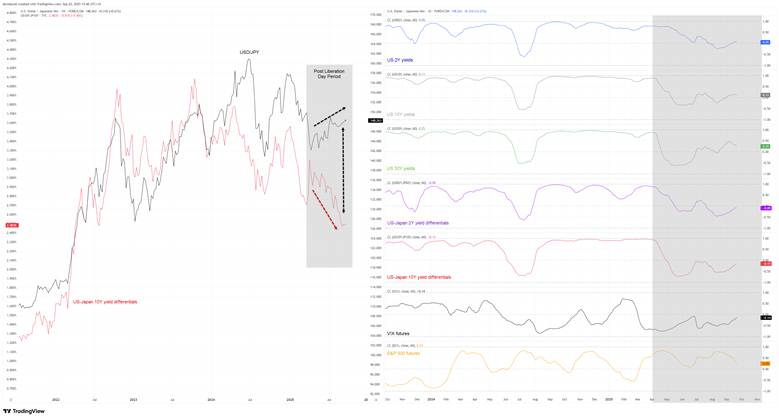
Source: TradingView
The tight link between USD/JPY and U.S. yields, along with the broader rate differential between the U.S. and Japan, was fractured by Donald Trump’s Liberation Day tariff announcement in April. It triggered a “sell America” trade that overrode these traditional drivers. The shaded window on the chart above highlights how the pair’s responsiveness to yields and yield spreads collapsed.
Since then, correlations with U.S. rates have started to re-emerge on shorter horizons, especially against Treasury yields and Fed rate cut pricing. They are not yet back to historic extremes, but the rebuilding link suggests U.S. data will likely be the dominant driver of USD/JPY in Q4.
What also stands out is the lack of correlation with other historic drivers. VIX and S&P 500 futures, once reliable markers of USD/JPY direction through the carry trade channel, have offered little signal recently. With yen funding costs creeping higher, the appetite for risk-sensitive carry trades may be fading, leaving the pair more tightly bound to the ebb and flow of U.S. rate pricing.
Fed, BOJ Pricing in Focus
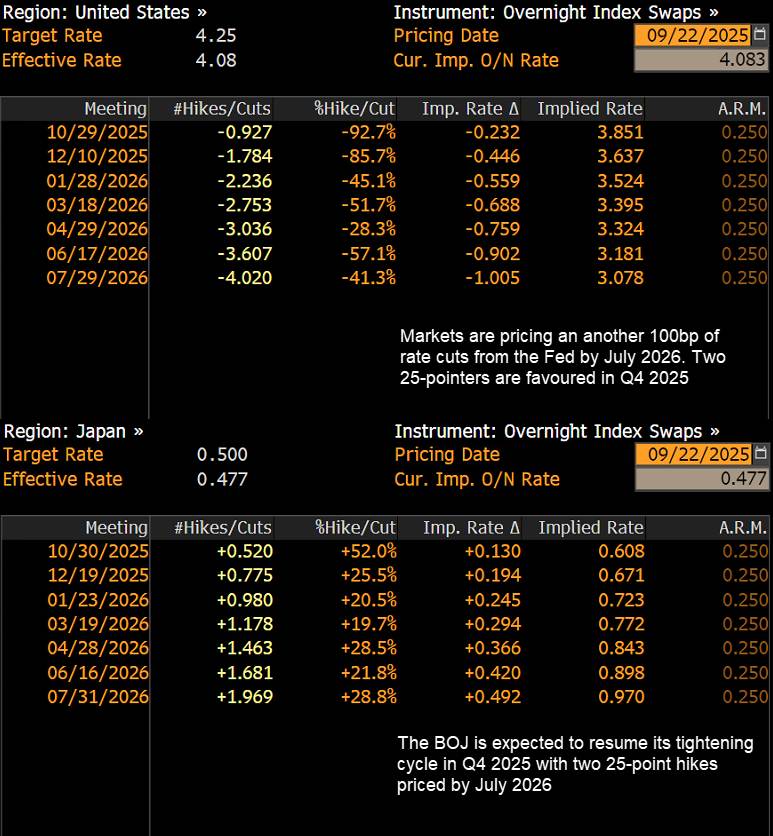
Source: Bloomberg
Markets have firmed their bets on further Fed easing following a resumption of the easing cycle in September. Swaps imply 100 basis points of cuts by July next year, with two 25-point moves seen as highly likely before year-end. After that, the pace slows to one cut per quarter.
For the Bank of Japan, October is in play. A 25-point hike is currently a coin toss, reflecting the two board members who dissented in favour of tightening at the September meeting. This is highly unusual for the BOJ, particularly under Governor Ueda, raising the possibility it was designed to prepare markets for a move when the next set of forecasts arrives. By November, the implied probability climbs to just under 80%, with a full hike effectively priced by January.
Looking further ahead, another 25-point increase by July is seen as near certain at just under 97%.
Key U.S. Fundamental Drivers
The Federal Reserve has made clear its bias. It is far more sensitive to labour market weakness than inflation overshoots, as shown by the decision to resume its easing cycle in September despite evidence of building price pressures, led by services rather than goods. That places increased weight on the remaining nonfarm payrolls reports this year, even with legitimate doubts over their reliability given the hefty downward revisions of recent years.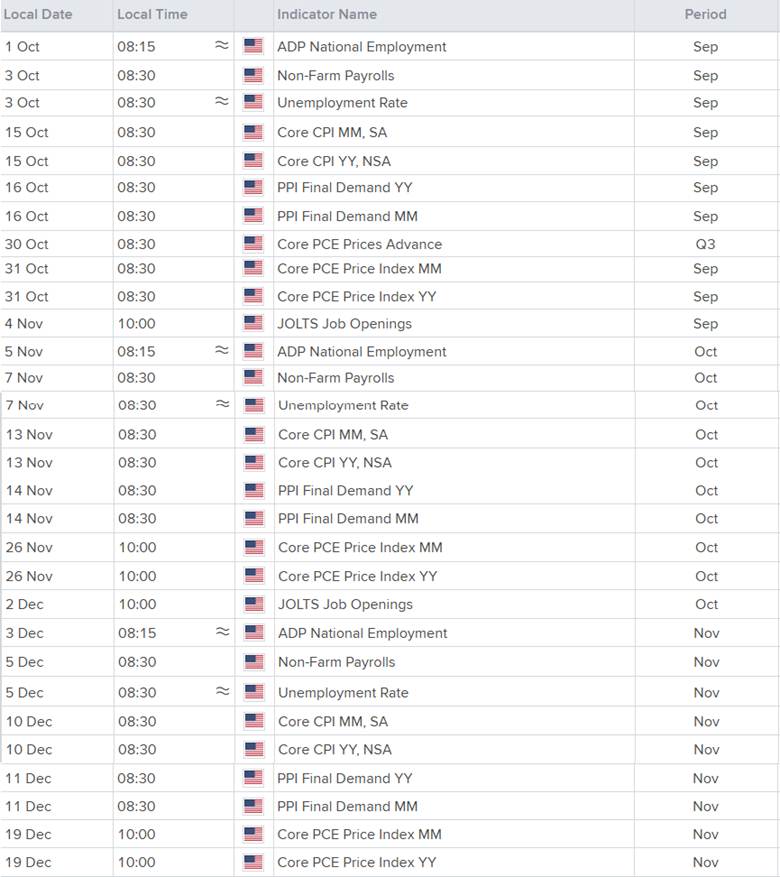
Source: LSEG (U.S. ET shown)
Jerome Powell has already flagged concern that the “low firing, low hiring” environment could be a precursor to higher unemployment. That puts other labour market gauges firmly in focus, including JOLTS, weekly jobless claims and the ADP Employment report, with the latter arguably offering a more consistent read on hiring than payrolls.
Until the Fed is satisfied that risks around the labour market have passed, inflation reports are likely to remain a secondary consideration, unless they too begin to soften. Of the inflation measures, CPI and PPI are the ones that markets tend to move on, even though the Fed’s preferred metric is the core PCE deflator.
Beyond the data, Fed independence remains a key risk. The potential removal of Lisa Cook as governor could spark a wave of dollar selling, paving the way for another handpicked appointment to push a dovish agenda. That not only raises the risk of easier monetary settings but also upheaval among the regional Fed presidents, given that the governors hold sway over appointments.
Jerome Powell’s future also matters. His term as Fed chair ends in May, and while he has the right to stay on as a governor until January 2028, history suggests he may choose not to. Should Cook keep her seat, Powell could become the swing factor between an uber-dovish FOMC and the committee.
Will History Repeat to Rescue the Dollar?
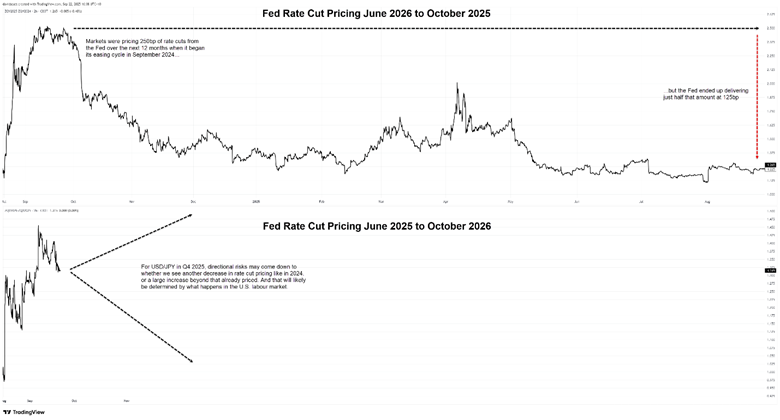
Source: TradingView
In 2024, markets briefly priced an aggressive easing cycle after weak July and August payrolls reports, with around 250bp of cuts seen in the year to September 2025. That signal proved false. Rate cut pricing collapsed, the dollar rallied as traders were caught out by placing too much emphasis on a single data source.
The parallels today are hard to ignore. While we do not have a U.S. election in play, the setup is similar. Summer payrolls softness has lifted the odds of near-term Fed easing, with concerns about Fed independence adding a dovish tilt to positioning. If payrolls remain the focus, it risks missing the signal from other economic indicators.
Consumer spending, GDP, inflation measures and even the steepening of parts of the U.S. curve do not point to an economy on the brink. Fiscal policy remains highly expansionary, and financial conditions are loosening. Unless you subscribe to the idea that AI is about to replace everyone’s job, perceived labour-market risks look overstated. If that view fades, rate cut pricing could retrench and the dollar regain upside momentum—just like 2024.
The wildcard is politics and personnel. A rapid shift in the FOMC’s composition, whether through changes to Lisa Cook’s position or Jerome Powell’s future, could entrench a more dovish stance regardless of the data.
Key Japanese Fundamental Drivers
For Japan, the focus is clearer: the inflation outlook. Of the two monthly releases, Tokyo CPI tends to be the more influential for markets, given it arrives three weeks before the national report. Beyond inflation, wage growth, unemployment and household consumption will also matter given their role in feeding into price dynamics.
The virtuous cycle between higher wages and sustained domestic inflation needs to strengthen further. Trade flows with the U.S. and other major partners cannot be ignored either, with obvious implications for domestic conditions.
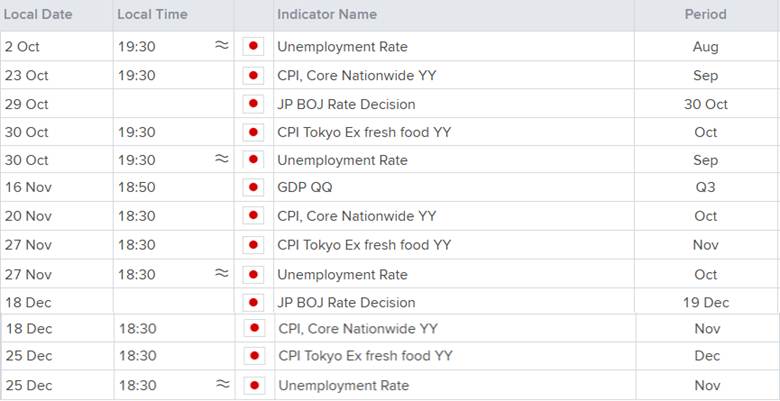
Source: LSEG (U.S. ET shown)
Politics may also play a role. The Liberal Democratic Party is expected to hold a leadership vote in early October, determining Japan’s next prime minister. The winner could have sway over how persistent the Bank of Japan is in pursuing reflationary policies at a time when voters remain uneasy with inflation running high by the nation’s standards.
USD/JPY Technical Analysis
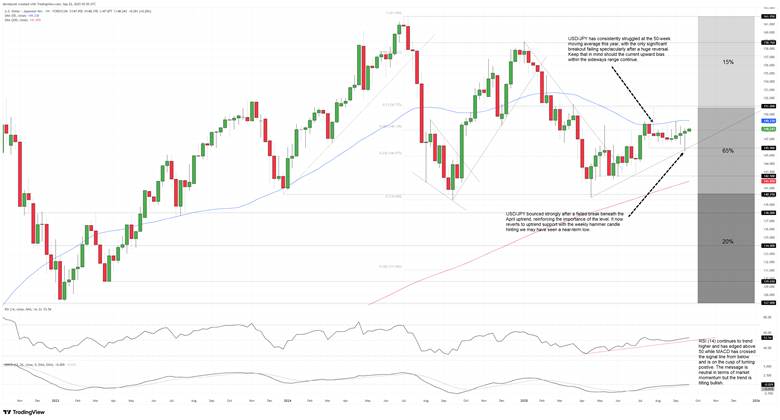
Source: TradingView
USD/JPY has traded between 151.00 on the topside and 140.25 on the downside for most of 2025, with violent reversals from both levels reinforcing their significance. More recently, the range has narrowed, with sellers using pushes above 148.00 up to the 50-week moving average to lean into strength.
On the downside, dips below 147.00 have attracted bids, with the only meaningful move beneath that level triggering a sharp reversal following a failed break of the April uptrend. The hammer candle that subsequently printed signals near-term upside risks heading into Q4.
Resistance may be encountered at the 50-week SMA, 151.00, 158.76 and 161.95. On the downside, key levels include the intersection of uptrend and horizontal support around 146, 142.50, 140.25 and 138.00.
Momentum indicators point to shifting directional risks. RSI (14) is trending higher and now above 50, while MACD has crossed the signal line from below, though it remains just in negative territory. Overall, acute downside pressure has largely dissipated, with momentum now neutral, with risks beginning to tilt bullish. This puts more emphasis on price action to gauge directional risks rather than maintaining a fixed bullish or bearish bias.
USD/JPY Q4 Forecast
Looking ahead, USD/JPY is favoured to remain within the 140.25 to 151 range that has dominated most of the year, with a 65% probability attached. In this scenario, labour market concerns fail to materialise while Fed independence fears constrain how much dovish pricing can be unwound before year-end.
A topside break of the range is deemed the least likely outcome at 15%. This would require the U.S. economy to run hot, pushing inflation higher while Fed independence fears fail to materialise. Under this scenario, the dollar could see meaningful upside.
The downside scenario carries a 20% probability. Any move lower would probably be driven by renewed concerns over Fed independence rather than a weakening U.S. economy, creating an environment where the dollar struggles.
Without the political overlay, the likelihood of a topside break would be significantly higher than a downside move, but history suggests Trump usually ends up getting his way.
